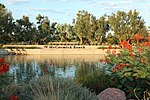The School of Architecture

The School of Architecture is a private architecture school in Paradise Valley, Arizona. It was founded in 1986 as an accredited school by surviving members of the Taliesin Fellowship. The school offers a Master of Architecture program that focuses on the organic architecture design philosophy of Frank Lloyd Wright. The school is the smallest accredited graduate architecture program in the United States and emphasizes hands-on learning, architectural immersion, experimentation, and a design-build program that grew out of the Taliesin Fellowships’ tradition of building shelters in the Arizona desert. The school is not ranked by any ranking publications. It is located on two historic campuses: Cosanti in Paradise Valley and Arcosanti near Mayer, Arizona. It was located at Taliesin West in Scottsdale, Arizona and Taliesin in Spring Green, Wisconsin, but in 2020 announced a move to Cosanti and Arcosanti.
Excerpt from the Wikipedia article The School of Architecture (License: CC BY-SA 3.0, Authors, Images).The School of Architecture
East Doubletree Ranch Road,
Geographical coordinates (GPS) Address Nearby Places Show on map
Geographical coordinates (GPS)
| Latitude | Longitude |
|---|---|
| N 33.567166666667 ° | E -111.94194444444 ° |
Address
East Doubletree Ranch Road 6469
85253 , Paradise Valley
Arizona, United States
Open on Google Maps






